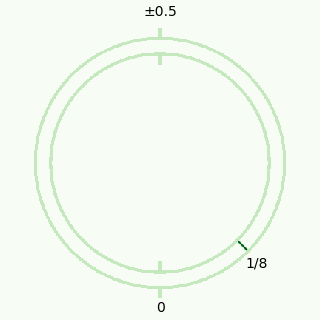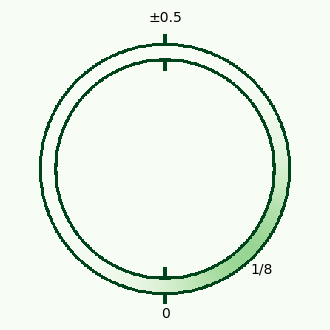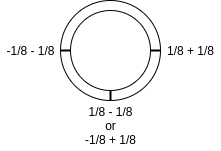Intuitive Definition of Torus
- Also known as circle group, written as .
- It's good to imagine the angle of a clock hand
- As a concrete number, it's the angle of the hand divided by 2π
What is Torus
- Here, we define it as . That is, the fractional part of a real number, taking values in or
- For understanding the theory, alone is sufficient
- may be more efficient in implementation
- Multiplication between Torus values is not defined, but addition is
- Example of addition: ,
- Multiplication cannot be defined. Example: Since and , if multiplication could be defined, , but this doesn't hold
- Multiplication with integers () can be defined. Example:
Modular Gaussian Distribution
- Used in the original TFHE paper
- Normal distribution samples take values in real numbers (), but this takes values in Torus
- Discrete Gaussian distribution is defined on integers, but this is Torus
- Since actual implementation approximates to integers, there's an argument that discrete Gaussian distribution or CBD should be used
- Uniform distribuiton is another option, since we can define it naturally in Torus
- Samples from normal distribution taken give modular normal distribution
- Using this for error is most standard (not best) in TFHE
Specific Construction of TLWE (when plaintext is Torus)
- is the set of binary values.
- Two parameters determine encryption security:
- Let be the uniform distribution taking values independently from
- Let be the modular normal distribution with mean and standard deviation
- Let , , ,
- is plaintext, , ,
- Ciphertext is , an element vector, where
- Since , if we add a method to remove , we can extract and decrypt
- The larger and , the more secure (if is too large, the ciphertext breaks)
Visual Image (Noise from Encryption)
| Plaintext |
With Noise |
 |
 |
- As emphasized, the probability of decryption error is not zero (negligible in practice)
- Generally, below is considered acceptable
- It's said that this is about the error probability on a typical PC
Additive Homomorphism of TLWE
- Consider two ciphertexts , , and let their sum be
- , and since appears, we can see additive homomorphism
- Since the error also becomes , there is a limit to the number of additions that can be performed
- If the error is too large, the probability of decryption error increases
Specific Construction of TLWE (when plaintext is binary)
- Let ,
- TLWE ciphertext is
- Decryption is ( is the sign function)
- During decryption,
Visual Image (Addition without Noise)

Visual Image (Addition with Noise)

Idea of Binary Operations
- Plaintext encoded in Torus is {-1/8, 1/8}
- Plaintext of sum of two TLWEs is {-1/4, 0, 1/4}
- Subtracting this from gives {-1/8, 1/8, 3/8}
- -1/8 occurs when both ciphertexts are 1 as binary plaintext
- 3/8 when both are 0, 1/8 when the two are different
- When decrypting this ciphertext, negative signs become 0, positive signs become 1
- That is, it becomes 0 only when both input ciphertexts are 1, so it's NAND
- ∴ If decryption can be evaluated on ciphertext, NAND can be computed on ciphertext
Visual Image (All Patterns of Addition without Noise)
- When subtracting the sum of two inputs from , only when both are 1 is it in the left half
- Becoming 0 only when both are 1 is exactly NAND
- The signs and constant values for the initial addition/subtraction are determined this way
- Other 2-input logic gates can be made by choosing similarly

Bootstrapping
- The operation of removing error by evaluating the decryption function on homomorphic encryption
- Craig Gentry first proposed this and gave a construction
- All current fully homomorphic encryptions are constructed by this
- In TFHE, the operation called Blind Rotate is essentially Bootstrapping
Implementation of Torus
- Since it's a set of fractional parts of real numbers, one naturally wants to implement it with double-precision floating-point numbers
- However, with floating-point numbers is heavy
- Therefore, we use fixed-point numbers where the decimal point is before the most significant bit
- Example: For 8-bit width, is , is
- With this method, the integer part from addition or multiplication is discarded by overflow, so modulo operation is not needed
- Example: For 8-bit width,
- The width of the fixed-point number should be sufficient to express
- That is, the sufficient width is determined by the standard deviation of the modular normal distribution
Implementation of Real Number and Torus Conversion
- Implementation of modular normal distribution requires conversion between real numbers and Torus
- Ideally, it's the operation of extracting the fractional part of a real number
- Let the operation to extract the integer part of a real number be , the fixed-point width be , and the input real number be
- To extract just the fractional part of a real number, is sufficient
- Actually, since we want a fixed-width fixed-point number, we extract the top digits of the real number as an integer
- The operation we want to implement can be written as the following formula
Centered Binomial Distribution (CBD)
- One of the noise distributions used besides modular normal distribution
- Discrete normal distribution is also commonly used
- Since it cannot be defined on Torus, it can only be used after discretizing Torus
- Defined using random variables that take 0 or 1 with equal probability
- is a parameter, and as it increases, the tail widens
- Advantages are ease of computation and bounded value range
About TLWE Parameters
- In this lecture, we introduce values currently estimated to be 128-bit security
- , or , fixed-point width is 16 bits
- TLWE security reduces to LWE security problem, so LWE estimation methods can be used
- Theory is explained with Torus, but implementation uses quotient ring with modulus
- In that sense, discrete normal distribution or CBD should be used rather than modular normal distribution
- Which is more essential, quotient ring or Torus? (I sometimes wonder)
- LWE Estimator is the de facto standard for security evaluation
- Code example for security estimation is here
About Random Number Generation
- Encryption security is greatly affected by random number quality
- Mersenne Twister should not be used (Pokemon RNG manipulation)
- The original paper author's implementation uses it, but don't imitate
- The safest is to use random numbers provided by the OS (on Linux, /dev/urandom)
- Pseudorandom numbers whose cryptographic security is guaranteed are called CSPRNG (Cryptographically Secure PseudoRandom Number Generator)
- TFHEpp uses BLAKE3's eXtended Output Function (XOF) mode
Minimum Implementation for TLWE
- Just list what's needed to make HomNAND, so whether to make it more general is up to design philosophy
- Just implement encryption and decryption limited to binary plaintext
- Addition of ciphertexts is used later, so it's good to hold data in a way that makes vector-like addition easy
- TFHEpp holds it with std::array, but overloading operators with classes is more common
- Depending on your philosophy
- The form rather than is more common
- Recently I feel this is slightly more efficient in terms of memory access
- Parameters should be written so they can be easily changed later for higher versatility




